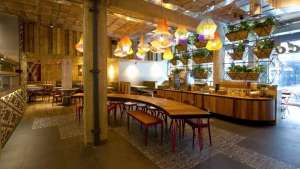Tracy Lee Lynch seems able to transform any space into something truly special. No doubt her years of experience in interior design, branding, visual communications, art directing and publishing have played a huge role, but equally valuable is her innate sense of aesthetics and her flawless eye for design.
Lynch was recently responsible for bringing together the best of South African design for Nando’s Central Kitchen project, as part of the brand’s wider campaign to celebrate and advocate homegrown design. From where she is sitting right now, Lynch has one of the best industry views on budding local talent, whose work can only further fuel her passion for design and the future of our creative economy. Here, we ask the designer/stylist/curator a few questions to better understand how she does what she does so well.
Tell us a little about your work with Nando’s and in SA design?
On the Central Kitchen project my role was creative director and lead curator. Currently I work as part of the international design team. My role is focussed on inspiration and creative direction, helping the interior designers that work on Nando’s all over the world to understand the Nando’s aesthetic and what a forward-thinking African aesthetic can look like. I also connect interior designers with SA designer-makers to create pieces for the restaurants internationally.
My design philosophy is that collaboration is key. Harnessing the creative energy of South African designers, crafters and makers has resulted in the rich and layered interior story at Nando’s Central Kitchen. There, the process of infusing spaces with pieces that result from collaboration meant that as a designer I was challenged to become a designer curator. This process added extraordinary value to the end product and allowed the true creative spirit of South Africa to infuse with the spaces at Central Kitchen.
What goes into curating design pieces that is different to art?
Apart from expressing the overall, aesthetic design vision, designed pieces for interior projects have a functional role. Furniture pieces and lighting installations need to fulfill practical needs. This makes the process somewhat different to curating artworks.
Is there a difference between design and art these days?
The divisions are often blurred, but for me, design sets out to solve design challenges whether aesthetic or functional; art is less about problem solving and more about questioning, illuminating and provoking interaction with humanity.
What is it like being in the business of creating positive promotion for South Africa through design?
It’s challenging and rewarding. There are so many misconceptions about what goes on in South Africa. I love how design can communicate with such optimism, free from our hangups, and express the future with such positive energy.
What is your definition of “meaningful design”?
Design that inspires change, presents solutions, shifts thinking and evokes delight.













